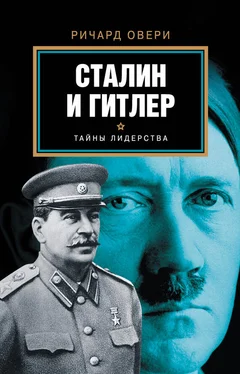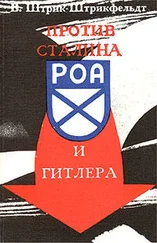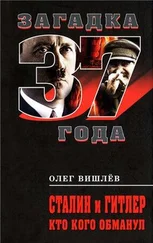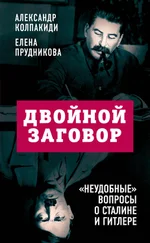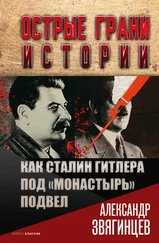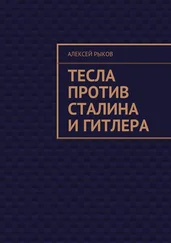5. S. Courtois, N. Werth, et al. The Black Book of Communism: Crimes, Terror, Repression (Cambridge, Mass., 1999).
6. D. Rayfi eld Stalin and his Hangmen (London, 2004). On Hitler, R. G. Waite The Psychopathie God: Adolf Hitler (New York, 1978); E. H. Schwaab Hitler’s Mind: A Plunge into Madness (New York, 1992); F. Redlich Hitler: Diagnosis of a Destructive Prophet (Oxford, 1999), esp. ch. 9.
7. A. Bullock Hitler and Stalin: Parallel Lives (London, 1991).
8. On Hitler there is the standard two-volume biography by I. Kershaw Hitler: Hubris 1889–1936 (London, 1998) and Hitler: Nemesis 1936–1945 (London, 2000). On Stalin, D. Volkogonov Stalin: Triumph and Tragedy (London, 1991); S. Sebag Montefi ore Stalin: The Court of the Red Tsar (London, 2003).
9. On Germany see M. Burleigh The Third Reich: a New History (London, 2000); on the Soviet Union, R. Service A History of Twentieth-Century Russia (London, 1997).
10. R. H. McNeal Stalin: Man and Ruler (London, 1988), p. 237.
11. F. Genoud (ed.) The Testament of Adolf Hitler (London, 1960), p. 100, entry for 26 February 1945.
12. H. Heiber and D. M. Glantz (eds) Hitler and His Generals: Military Conferences 1942–1945 (London, 2003), p. 388, meeting of the Führer with General Reinecke, 7 January 1944.
13. On Stalin see E. van Ree The Political Thought of Joseph Stalin (London, 2002). On Hitler, R. Zitelmann Hitler: the Politics of Seduction (London, 1999); F. L. Kroll Utopie als Ideologie: Geschichtsdenken und politisches Handeln im Dritten Reich (Paderborn, 1998).
14. On German infl ation G. Feldman The Great Disorder: Politics, Economics, and Society in the German Infl ation 1914–1924 (Oxford, 1993); on Soviet infl ation L. E. Hubbard Soviet Money and Finance (London, 1936), chs. 1, 4.
15. V. Serge, The Case of Comrade Tulayev (London, 1968), p. 88.
1. A. Hitler Mein Kampfe ed. D. C. Watt (London, 1969).
2. R. Service Lenin (London, 2000), pp. 462–5.
3. Service, Lenin, p. 467; E. Radzinsky Stalin (London, 1996), pp. 193–4.
4. Service, Lenin, p. 469.
5. B. Bazhanov Avec Staline dans le Kremlin (Paris, 1930), p. 43.
6. D. Volkogonov Stalin: Triumph and Tragedy (London, 1991), pp. 93–4; Bazhanov, Avec Staline dans le Kremlin, p. 48.
7. E. Hanfstaengl Hitler: the Missing Years (London, 1957), p. 108.
8. L. Gruchmann and R. Weber (eds) Der Hitler-Prozess 1924: Wortlaut der Hauptverhandlung vor den Volksgericht München
(4 vols, Munich, 1997) vol. i, pp. xxxv – xxxvii.
9. O. Gritschner Der Hitler-Prozess und sein Richter Georg Neithardt (Munich, 2001), p. 42.
10. Gruchmann and Weber, Der Hitler-Prozess, vol. iv, p. 1591.
11. Hanfstaengl, Hitler, p. 114; W. R. Hess (ed.) Rudolf Hess: Briefe, 1908–1933 (Munich 1987), p. 322, letter from Hess to Use Pröhl, 12 May 1924.
12. Gritschner, Der Hitler-Prozess, p. 62.
13. On Stalin, W. Duranty Stalin and Co: The Politburo and the Men who Rule Russia (London, 1949), p. 39; on Hitler, Imperial War
Museum, Speer Collection, Box 369, Part III, exploitation of Albert Speer, ‘Adolf Hitler’, 19 Oct 1945, p. 19. See too, T. Junge Until the Final Hour. Hitler’s Last Secretary (London, 2003), p. 130, who recalled Hitler’s comment after the bomb exploded at his headquarters in July 1944: ‘Well, ladies, everything turned out all right again. Yet more proof that Fate has chosen me for my mission.’ See too, W. S. Allen (ed.) The Infancy of Nazism: The Memoirs of Ex-Gauleiter Albert Krebs 1923–1933 (New York, 1976), p. 181: ‘Providence,’ Hess told Krebs in 1931, ‘has always inspired him [Hitler] to do the right thing.’
14. Duranty, Stalin and Co, p. 38.
15. On his medical history N. Romano-Petrova Stalin’s Doctor: Stalin’s Nurse: A Memoir (Princeton, NJ, 1984), pp. 5–6.
16. On Stalin’s many revolutionary nicknames see The Life of Stalin: a Symposium (London, 1930), p. 3; on Siberia A. V. Baikaloff I Knew Stalin (London, 1940), pp. 27–9.
17. See for example Joseph Stalin: a Short Biography (Moscow, 1949), p. 55, ‘Stalin was Lenin’s closest associate. He had direct charge of all the preparations for the insurrection [in 1917]’ or p. 76, ‘It was Stalin who directly inspired and organized the major victories of the Red Army [in the civil war]’. The same portrait appears in Short History of the Communist Party of the Soviet Union (Moscow, 1942) (so-called ‘Short Course’) pp. 206–7.
18. Joseph Stalin Works, vol. iii, p. 67, ‘What did we expect from the conference?’ in Soldatskaya Pravda, 6 May 1917.
19. Stalin, Works, vol. iii, p. 408, Speech at a meeting of the Central Committee, 16 October 1917.
20. R. Tucker, Stalin as Revolutionary 1879–1929 (New York, 1973), pp. 179–82.
21. Cited in Tucker, Stalin, pp. 178–9; Trotsky’s remark in D. Volkogonov Trotsky: The eternal revolutionary (London, 1996), p. 322.
22. Baikaloff, I Knew Stalin, p. 29.
23. Tucker, Stalin, p. 181; S. Graham Stalin: an Impartial Study of the Life and Work of Joseph Stalin (London, 1931), p. 39.
24. M. Voslensky Nomenklatura: Anatomy of the Soviet Ruling Class (London, 1984), p. 47.
25. Duranty, Stalin and Co, p. 30; E. Lyons Stalin: Czar of all the Russians (London, 1940), pp. 176–7; Baikaloff, I Knew Stalin, p. 28, ‘He spoke haltingly, with a strong Georgian accent; his speech was dull and dry’; Graham, Stalin, pp. 117–19.
26. Volkogonov, Stalin: Triumph and Tragedy, pp. 225–9.
27. Tucker, Stalin, p. 175. ‘There is a dogmatic Marxism,’ Stalin said in a debate in August 1917, ‘and a creative Marxism. I stand on the ground of the latter.’
28. The story of the cutlery in A. H. Birse Memoirs of an Interpreter (London, 1967), p. 160.
29. Tucker, Stalin, p. 212.
30. Baikaloff, I Knew Stalin, p. 85, repeating a story told by Noah Dzhordania.
31. Baikaloff, I Knew Stalin, p. 84.
32. Lyons, Stalin: Czar, p. 175; see too his account in E. Lyons Assignment in Utopia (London, 1937), pp. 381–9: ‘his swarthy face’ had, Lyons recalled, ‘a friendly, almost benignant look’.
33. Graham, Stalin, p. 119: ‘Calm and immobile sits Stalin,’ wrote one observer, ‘with the stone face of a prehistoric dragon, in which alone the eyes are living.’
34. Graham, Stalin, p. 79; Tucker, Stalin, pp. 21 off.
35. S. Sebag Montefi ore Stalin: the Court of the Red Tsar (London, 2003), pp. 1–18 on the suicide of his second wife; A. Reiss (ed.) Molotov Remembers: Inside Kremlin Politics. Conversations with Felix Chuev (Chicago, 1993), pp. 177–8 on Stalin’s drinking habits: ‘Stalin didn’t drink much, although he pushed others to do it. Apparently he considered it a useful way to test people.’
36. Interview with Dmitri Volkogonov, episode 1, Russia’s War documentary, 1997.
37. Tucker, Stalin, p. 209.
38. Graham, Stalin, p. 93.
39. A. Amba I Was Stalin’s Bodyguard (London, 1952) p. 69.
40. E. W. Tennant True Account (London, 1957), pp. 182–3.
41. On his liking for the Austrian Jewish composer before 1914 see B. Hamann Hitler’s Vienna: a Dictator’s Apprenticeship (London, 1999), pp. 64–6, 349.
42. Hamman, Hitler’s Vienna, pp. 398–402; W. Maser (ed.) Hitler’s Letters and Notes (New York, 1977), pp. 27–31.
43. Maser, Letters and Notes, p. 45, letter from Hitler to Anna Popp, 20 October 1914.
44. Maser, Letters and Notes, pp. 52–5, letter from Hitler to Joseph Popp, 1 November 1914.
45. Hitler, Mein Kampf, p. 150.
46. Hitler, Mein Kampf, pp. 186–7. See an analysis of Hitler’s psychological state in F. Redlich Hitler: Diagnosis of a Destructive
Prophet (New York, 1999), pp. 286–317.
47. A. Joachimsthaler Korrektur einer Biographie: Adolf Hitler 1908–1920 (Munich, 1989), pp. 250–53.
Читать дальше
Конец ознакомительного отрывка
Купить книгу
